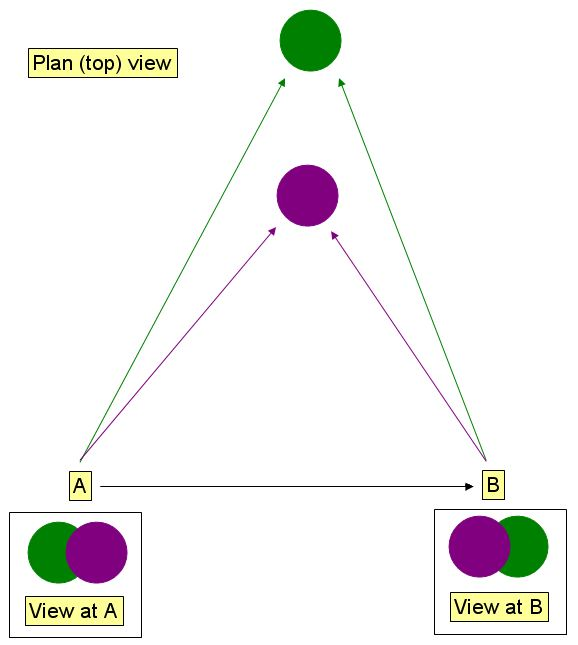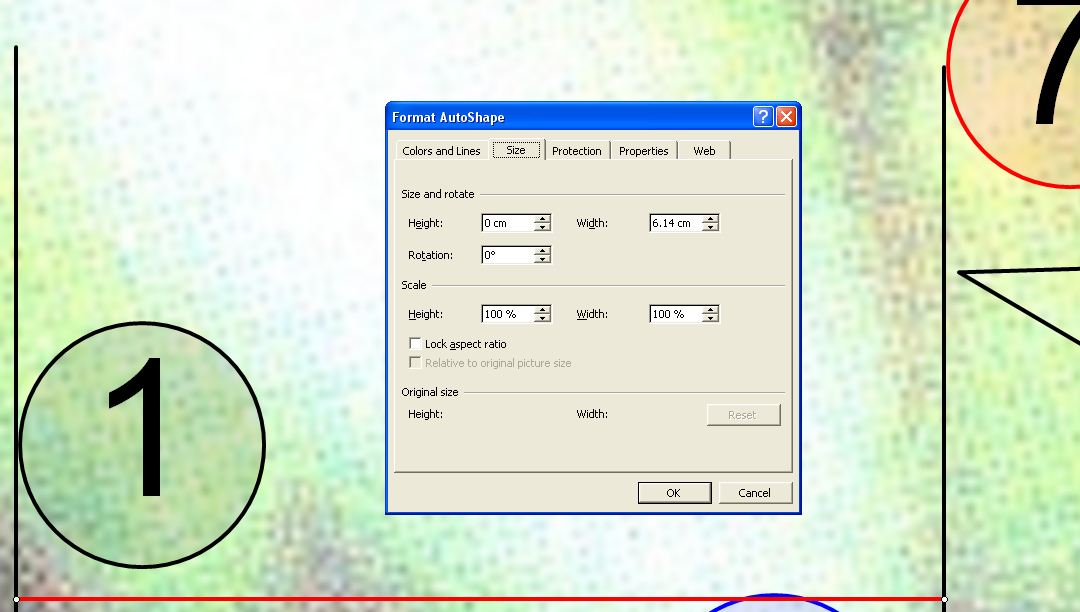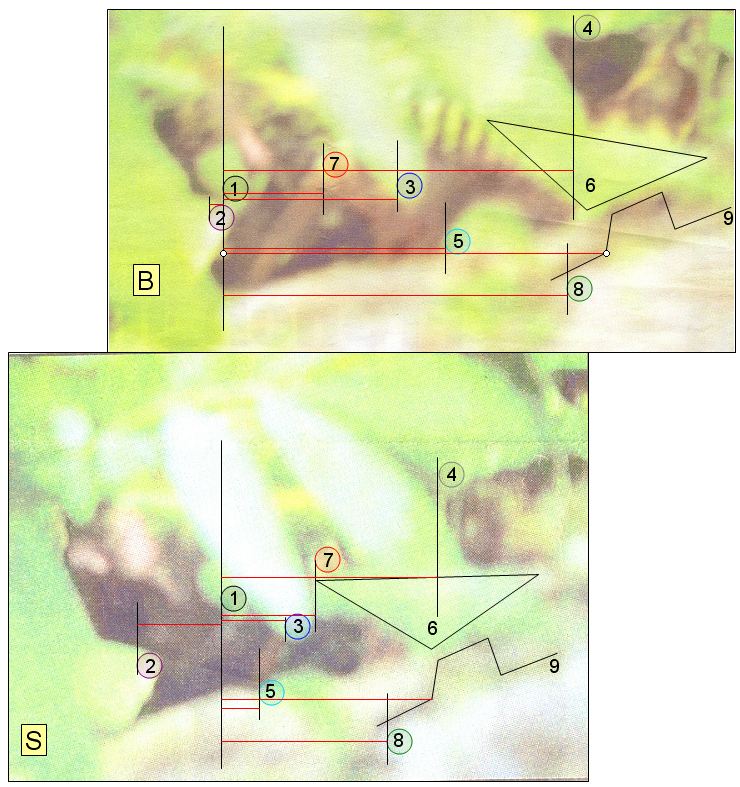Emmerichs thylacine - geometric analysis
A quick note (part 6)
Before we get back on track with the main aim of the image analysis, just a quick note about my last post here at Where Light Meets Dark. Thanks to Anton Higgins' analysis, I drew the conclusion that we could not dismiss Klaus Emmerichs' February 2005 photos of a thylacine on the basis that its stripes are similarly positioned and spaced to those of a thylacine in a 1933 photograph.
Leading in to that, in the post before, I was examining an odd marking on the hind leg of Emmerichs' thylacine. A similar mark was found in the 1933 photo, but the dark colouration across the animal's stomach seemed poorly aligned between photos. In that post I implied that if the 2005 photos were a hoax, then perhaps they were created using a different version (or scale) of the 1933 image than that used in my analysis.
In all fairness, and in light of Higgins' striping pattern analysis, I should add that another possible explanation is that Emmerichs did in fact photograph a live thylacine and did not use a pre-existing photograph to produce a hoax.
We will return to the job of reconstructing the scene as Emmerichs photographed it, in the next post.
Getting close (part 7)
It's time to return to the task at hand... did the thylacine move between the first and second photos taken by Klaus Emmerichs in Tasmania in February 2005?
Figure 08 - Analysing the relative positions of elements between the photographs.
The scaled images were approximately horizontally aligned with respect to the thylacine (as per previous figures). The top image (labelled "B") is the bigger of the two images published at Cryptomundo. The bottom image (labelled "S") is the smaller. Points which can be clearly seen in both images were then labelled numerically. The circles have no significance other than to mark the point. The triangle labelled "6" was drawn over image S, then copied to image B and rotated over image B until the best match was found. It is the same size in both images. The lines labelled "9" were drawn over the darker areas on the log on image S, then copied and placed over image B. The lines are the same size and orientation in both images
A description of each data point follows:
1 - the lowest point on leaf L1 such that the circle that marks the point remains contained within the boundary of the leaf. This is the same leaf used for scaling up image S.
2 - the rightmost point of the leaf
3 - the lowermost point of the leaf
4 - the lowermost point of the leaf
5 - the lowermost point at the left of the leaf
6 - the basic outline of the leaf
7 - the 2 pale areas between stripes on the rump of the thylacine
8 - a pale region on the log which is bounded on top and on bottom by darker regions
9 - a sequence of lines traced through darker markings visible on the log
Change in relative positions
As can be seen, many of the data points have changed position relative to each other between photos. Some of these changes may be due to the camera being in a different position for each photo. Some of these changes (in leaf position) may be due to the leaves changing position between photos (for example, due to air movement or due to the thylacine moving them). I plan to test whether the thylacine itself changed positions between photos.
What should we expect?
The first thing we need to note before interpreting the changes observed in the data points, is what we expect to happen with regards to relative position, when the camera moves.
Consider the example below.
Figure 09 - Illustrating the effect of distance from viewpoint on relative horizontal movement as the viewer moves.
Plan (top) view of two arbitrary data points showing the way they appear from two points, A and B.
In this example, we are looking down on the scene. At first, the viewing point (or camera) is at point A. Viewing both dots from this position, you would see the purple dot on the right, and the green dot on the left, as shown by "View at A". In this particular case, the purple dot slightly overlaps the green dot. When the viewing position is changed (the camera moves) to B, the purple dot now appears to the left of the green dot. Therefore, the object in the foreground (closer to the viewing position, or camera), appears to move in the opposite direction to the camera between shots. (When the camera moved right, the foreground object appeared to move left in the image).
In addition, the closer a foreground object is to the camera, the further it will appear to move with respect to a background object, than, say an object halfway between them. This is not demonstrated here.
Finally, the same principle applies with respect to vertical movement. For example, if the first photo was taken whilst crouching, then the photographer stood up and took the second photo, then the camera has moved up between shots. Correspondingly, foreground objects would appear to move down between photos.
In the present analysis, there appears to be considerable horizontal movement between photos, and slight vertical movement (as will be shown below).
But it's not quite that simple
In the case of the thylacine photos, we don't know which was taken first, and which was taken second. For arguments sake, we will assume the lower (S) image was taken first, and the upper (B) image was taken second, although it doesn't really matter - what we're looking for is whether the thylacine moved with respect to its environment between photos. The assumption that the bottom photo was taken first is made simply to make the discussion easier to follow.
Some initial observations (some of which each need testing):
1 - We assume objects in the foreground appear to move in the opposite direction that the camera moves between shots
2 - We assume the bottom photo was taken first; although this is not important for establishing whether the thylacine moved, it aids discussion
3 - We assume the leaves did not significantly change relative position between photos
4 - We suspect that the leaves may have insignificantly changed relative position between photos
5 - We make no assumption as to whether the thylacine moved or not. Thus, arguments based on data point 7 cannot be used to establish facts about the environment around the thylacine.
6 - Leaf 3 overlaps leaf 1 in the first image (S)
7 - Leaf 3 is closer to the camera than leaf 1 (from statement 6)
8 - Leaf 3 moved right between photos (from 2, observation)
9 - The camera moved left between photos (from 1, 7, 8)
Note: at this point we have established that the camera moved left with respect to the scene, between photos (assuming the bottom photo was taken first). As a result, we can now measure the relative distances that objects moved left or right with respect to each other in order to determine the layering in which the objects appear. That is, which object is closest? Which is next further away? Right down to which object is furthest?
In particular, note that anything which appears to have moved right, with respect to leaf 1, must be in front of leaf 1. The further right it appears to move, the closer to the camera it is. Anything which appears to move left with respect to leaf 1, must be behind leaf 1. The further left it appears to move, the further away it is.
The figure below shows the process used for measuring horizontal distance between points. For the example, I have chosen leaf 1 (data point 1) and the thylacine (data point 7).
Figure 10 - The measurement process.
The image was zoomed to 400% (4x) and a vertical line was drawn against the left edge of each data point circle such that the line touches, but does not overlap the circle. A horizontal line was placed such that it overlapped each vertical line at each end. Not shown here, focus was moved away from the horizontal line so as to remove the selection points in order to confirm the position of the horizontal line. The properties for the horizontal line were displayed, and the horizontal dimension of the line can be read from the "Width" field in the "Size and rotate" section.
Two important notes; first, the exact measurement is irrelevant - we are interested in relative measurements. Second, this process assumes the circles are placed in exactly the same position relative to the object they represent in each image. Given that this precision is not possible, a 5% difference in measurement will be required in order for the difference to qualify as significant.
Figure 11 - Summary of distance of movement of identifiable points relative to data point 1.
Following is a table listing the relative differences in position between leaf 1 and every other label in the image. For each distance, a value of 5% (labelled "5%") and 95% (labelled "Change - 5%") is shown. Starting with the object nearest the camera (data point 5), the question was asked: "Does the next nearest object fall within 95% of the previous one?". If so, then the next nearest was ordered equally. If not, then the order was increased.
The verdict?
From the table, we have the order of objects as: leaf 5 and the log at 8 (equally), the log at position 9, leaf 4, leaf 3, leaf 2, the thylacine at point 7.
Figure 12 - illustrating the relative movements of identifiable points.
Reduced scale depiction showing where the horizontal measurements were made.
One very compelling conclusion from this discussion is that the environmental objects (leaves, log), move with a consistency that might be expected from a real scene. Specifically, the log at point 9 is in fact marginally further from the camera than at point 8 (as was measured and as would be expected). Likewise, the leaf at point 4 is in fact marginally further from the camera than the leaf at point 3 (as was measured and as would be expected from the leaf shape).
For this reason, I conclude that the appearance of the leaves and log is consistent with that which would be expected if two separate photos were taken of the same, real, three dimensional scene.
In other words, I believe the leaves and log are real and are not digital manipulations.
What about the thylacine?
At present, all that can be said from the data points examined, is that the thylacine is the furthest object from the camera. This still leaves open the possibility that the thylacine was digitally added to two legitimate photographs of the leafy scene.
The first step we need to take is to ascertain that there are objects in the scene which are further away than the thylacine. If this can be established, then we can reasonably assume that there was in fact a thylacine in the scene when the photographs were taken (so long as all measured horizontal movement remains consistent with what might reasonably be expected).
If this point is established, then we are forced to conclude that something resembling a thylacine was in fact photographed, twice, in situ.
Imagining for a moment that we establish that conclusion, then the next, and final question to ask, would be whether the thylacine changed its own position relative to its environment between photos. In fact, we will get the answer as soon as we identify objects behind the thylacine moving consistently with respect to the rest of the scene.
If the thylacine moved, then we must conclude that Mr Emmerichs either photographed a live thylacine, or he constructed a scene containing an object resembling a live thylacine and paid such attention to detail as to move it slightly between photographs.
This author (with all due respect) cannot at present hold any opinion on the character of Mr Emmerichs, but it is on record at Cryptomundo that Col Bailey, who has "been investigating claims of thylacine sightings for almost 40 years", has "thoroughly investigated [Mr Emmerichs'] claims and interviewed him at length, as well as visiting the location of his sighting and [is] of the opinion he is an honerable man and is telling the truth about this matter" (Bailey, 2006).
The final piece of the puzzle
And so the final piece of this puzzle looms. We shall return to seek to identify background objects and finally answer the question - do we have reasonable grounds to believe Mr Emmerichs' photos are of a live thylacine?
References
Bailey, C. Commenting on "Cryptomundo Exclusive: Thylacine Photos" (On-line) Accessed 5 August 2006 at http://www.cryptomundo.com/bigfoot-report/thylacine-photos
Copyright notice
The Emmerichs photographs, and derivative works, were removed from the former version of this website (at www.wherelightmeetsdark.com) in 2006 on request of Klaus Emmerichs. They were republished on 12 June 2019 under the defence of Fair Dealing under Australian copyright law. The original images and their elements as incorporated in derivative works are presented as they were published in the print version of Tasmanian newspaper, the Sunday Tasmanian in 2006. An attempt was made to contact Mr Emmerichs on 17 Mar 2017 ahead of the re-publication of these images but he could not be reached. For full details on how WLMD respects and supports copyright, please refer to the Terms and conditions of use. This note added 12 June 2019.
Revisions
12 June 2019 - Add part 6, republish images, minor caption changes and copyright notice.




